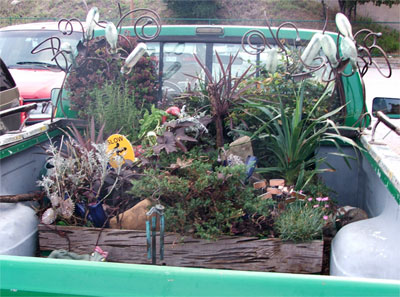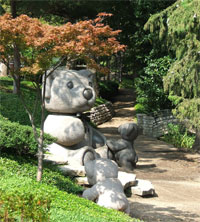Road Trip to Big D
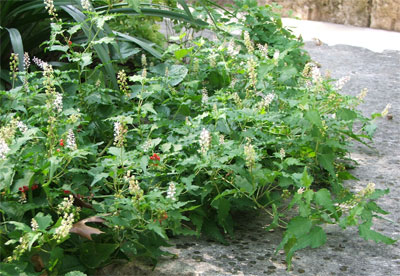
Pigeonberry (Rivina humilis).
All photos courtesy of Steven Chamblee.
Turk’s Cap and Pigeonberry
Is it just me, or was September just the best month ever? Toad-floating rain on the first day ended a parching summer drought that witnessed July rainfall relief completely surround but never fall on little ol’ Weatherford, Texas … not on my place, anyway. I actually saw cobwebs in my rain gauge. (I can’t complain too loudly about August, as I snuck up to Oregon for 12 of those 100+ degree days. — Don’t hate me … you would have done it, too.) The last week of this blessed month made me hunt up a jacket for the first time since March … hallelujah!
September also brought the Garden Writers Association’s annual conference to Big D, with Jimmy Turner and the Dallas Arboretum folks playing host for most of it. I witnessed a woman from Washington state rhetorically ask Jimmy, “How do you ever get used to this heat?” With his typical blunt candor, he replied, “You never get used to it. You just learn to suffer with style.” Before she could say anything else, he added, “This isn’t hot. When you have little ribbons of sweat running off your elbows … that’s hot.”
Anyhoo, after spending a few moments admiring the 2010 edition of Felder Rushing’s truck garden, I hopped on the bus with the rest of the folks to tour the jardins du jour. Now, normally I would not consider a bus ride around Dallas any kind of a road trip, but I found my own words echoing inside my head, “It’s not about the miles your body goes; it’s about the distance your mind travels.” Fair enough, I’ll give it a shot.
Twenty minutes later, we were cruising through sections of Big D that I never knew existed … probably because they keep such areas hidden to avoid riff-raff like me … Highland Park, Preston Hollow, and Turtle Creek. I was amazed and impressed … we were touring endless St. Augustine “turf farms”/lawns one minute, the set of CSI: Miami the next … then an Italian villa; a fantasyland for hobbits, a limestone cave/grotto, a minimalistic modern industrial ruin, gigantic stone teddy bears, and a 12,000-square-foot concrete and glass building touted to “blend seamlessly into the natural surroundings.” My brain pinged like a pinball — bouncing off delight, ricocheting off jealousy, plunging into the tunnel of inspiration, dropping into the “why didn’t I think of that” hole, flying up the ramp of audacity, then rattling repeatedly between the bumpers of environmental irresponsibility and brilliant horticultural achievement — before gently gliding between the flailing flippers of fatigue. What a morning!
And yet, there they were, right in the middle of all things fantastical: native Texas plants. From majestic live oaks to magenta-hued American beautyberry to multi-trunked yaupons, much of the bread and butter of these gardens were natives. I noticed two that rarely receive their due, so I’ll mention them here.
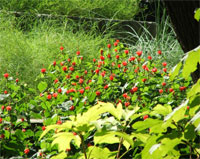
Turk’s cap (Malaviscus drummondii)
A bed of Turk’s cap (Malaviscus drummondii) in full bloom adorned a stacked wall planting. This loose, spreading shrub grows like an herbaceous perennial in North Central Texas, dying back to the ground most winters and attaining 3 to 6 feet by flowering time in autumn. The orange-red blossoms stand distinctively upright, with a thin, multi-styled pistil emerging from the delightfully twisted petals. Horticulturists have developed pink- and white-flowered varieties, the latter of which makes an excellent planting companion to pink rockrose (Pavonia lasiopetala).
A small swatch of pigeonberry (Rivina humilis) caught my attention. Long a favorite of many native plant people, this little herbaceous perennial has always eluded my abilities to culture it in a garden. Not that I couldn’t give it the negligence it needs to perform … I can do that. I just never could get well-meaning but unenlightened folks to stop yanking it out of my garden. You know, the old “gee, I don’t know what this plant is, so it must be a weed … so I’ll pull it” routine that causes so much misery to folks like me who try to grow more than petunias and marigolds. But, I digress. Pigeonberry is a rather delicate and unassuming plant that just needs a chance to flower and fruit to prove its worth. Only about a foot tall, it naturally grows under the protection of trees or shrubs. The three-inch long, pink and white flower spikes are held erect until the mature, translucent, ruby-colored fruits become heavy and bend the thin stems. Even small colonies of pigeonberry are stunning, particularly when backlighting causes the fruits to shimmer like precious gems.
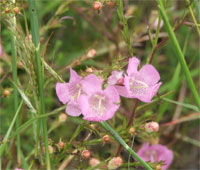
Gerardia (Agalinis homalantha), perhaps
So my trip to Big D ends with warm hugs and bittersweet goodbyes until next year’s GWA conference. The very next day I am out walking my meadow with two new friends whom I just met recently. (They needed a good place to call home, and I have a little extra room at my house, so it seemed like a good fit.) Over on the north side of the property, Rocky and Red led me over to a plant I have never seen on my place … a small-leaved, pink-flowered plant that appeared to be a scroph (member of the Figwort family). A little investigation led me to guess it is a flat-flowered gerardia (Agalinis homalantha), though I’ll have to do a little more research before declaring that a fact.
Ahhh, September … good rain, cool air, my birthday, new plants, old friends, new ideas, old gardens, and best of all, new puppies!
About the author: Steven Chamblee is the chief horticulturist for Chandor Gardens in Weatherford and a regular contributor to Neil Sperry’s GARDENS magazine and e-gardens newsletter. Steven adds these notes:
Come out to Chandor Gardens and see us sometime. Just take I-20 west to exit 409, hang a right, go 2.1 miles and hang a left on Lee Avenue. Head straight 12 blocks and you’re driving in the gates. Call 817-361-1700 to let us know you’re coming, and we’ll light the incense and show you around. You can always go to www.chandorgardens.com for a picture tour and more information.
I can always use another road trip! Let me know if you’d like me to come out and speak to your group sometime. I’m low-maintenance, flexible, and you know I like to go just about anywhere. No city too big; no town to small. Just send me an e-mail at schamblee@weatherfordtx.gov and we’ll work something out.


